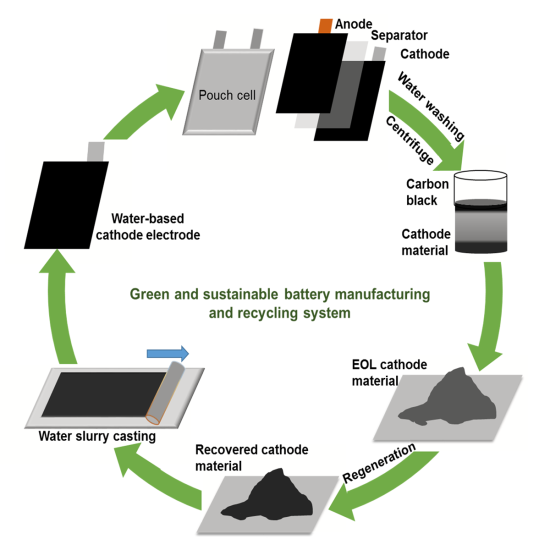What if we could make the process of making LIBs (Lithium Ion Batteries) a lot safer, their use less hazardous, and their recycling a low-risk enterprise? Virginia Tech researchers think they have positive answers to all three questions.
By substituting water for organic solvents normally used in making LIB electrodes, researchers at Virginia Tech (Virginia Polytechnic Institute and State University), “…found that the electrodes fabricated via water-based processing demonstrate comparable rate performance and cycle life to the ones from conventional solvent based processing.” Beyond that, in a seeming bit of alchemy, using water-based processing with a water-soluble binder, “…enabled recovering the cathode compound from spent electrodes using water, which could be successfully regenerated to deliver comparable electrochemical performance to the original, pristine electrode.”
“Humongous” Amount of NMP
N-methyl-2- pyrrolidone (NMP), used as a solvent in making LIB electrodes, is expensive and harmful to reproductive functions. It was added to the European Commission’s restricted list in 2018. Despite those concerns, one plant alone uses 4.1 million kilograms per year just for depositing cathode layers for 100,000 packs per year of 60 kilowatt, 10 kilowatt-hour plug-in hybrid vehicle (PHEV) batteries. According to Green Car Congress, the worldwide need to support 400 gigawatt-hours of battery production is “humongous,” a phrase not often used in scientific literature.
Savings From Water-based Processes
Processes with NMP are costly, with the electrode drying and recovery of NMP solvent accounting for 47 percent of the total process energy in LIB manufacturing. Replacing NMP with water would reduce that cost by one quarter. Dry room facilities that support slurry mixing and casting operations for moisture and temperature control consume another 29 percent of total energy.
Zheng Li and his Virginia Tech team concluded, “Excellent electrochemical performance was achieved from the water-based processed electrodes used in this work and comparable performance was obtained from the recycled materials. This methodology provides a green, sustainable process for LIB manufacturing and recycling if some underlying challenges can be resolved.”
Their results are published in the journal iScience in an article titled, “Water-Based Electrode Manufacturing and Direct Recycling of Lithium-Ion Battery Electrodes—A Green and Sustainable Manufacturing System.”
Reducing Hazards in Recycling

Despite large number of LIBs available at end of life, few are recycled, losing fortunes in desirable materials
Their work might make recycling lithium batteries easier, too. Partly because LIBs can flare up when damaged, and their electrolytes can spread across storage areas, space shared with other flammable materials such as paper or cardboard can be a potential inferno.
One operator termed LIBs “an existential threat” to the recycling industry. Hilary Gans of the South Bay Waste Management Authority explains the agency runs a MRF (materials recycling facility) that has experienced two fires per month caused by LI batteries. An LI battery-sparked fire at the agency’s Shoreline Environmental Center MRF cost $8.5 million in 2016.
Gans explained in a webinar, “They are bombs, they get crushed by the equipment, they get tangled up in the rolling stock and then tangled up in the MRF. And in a house of paper, you don’t want fires.”
“They are bombs, they get crushed by the equipment, they get tangled up in the rolling stock and then tangled up in the MRF,” Gans said in the October webinar by The Recycling Partnership. “And in a house of paper, you don’t want fires.”


